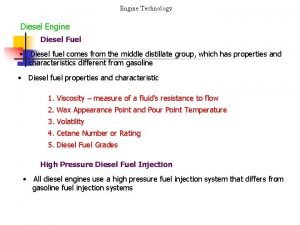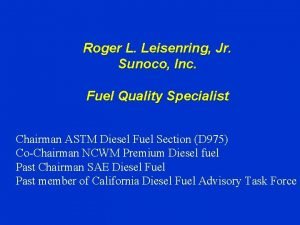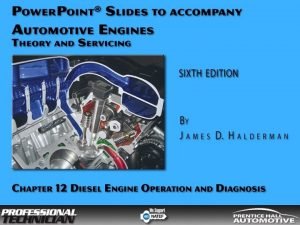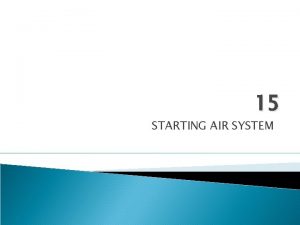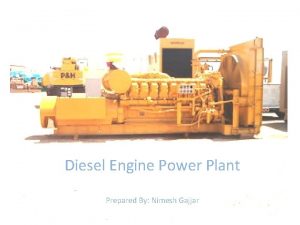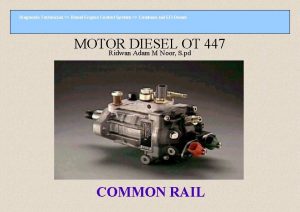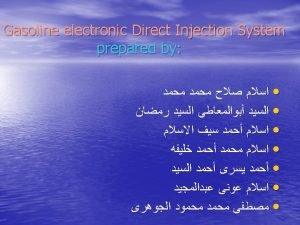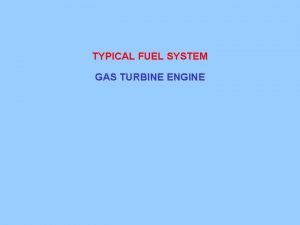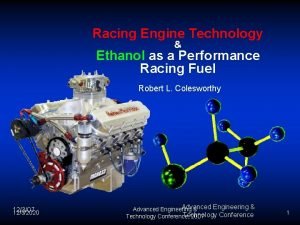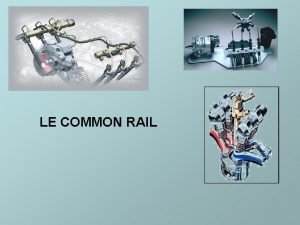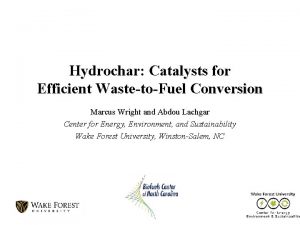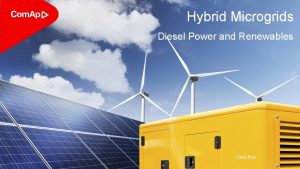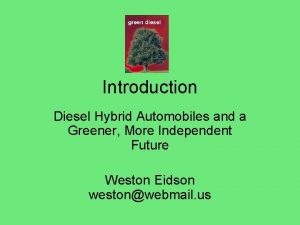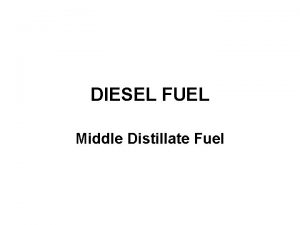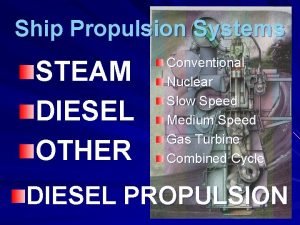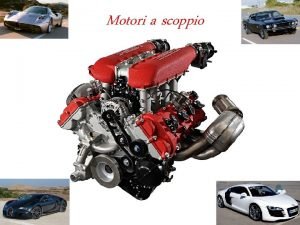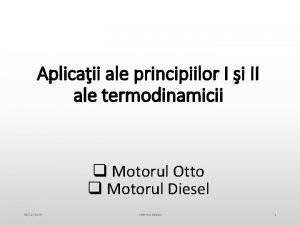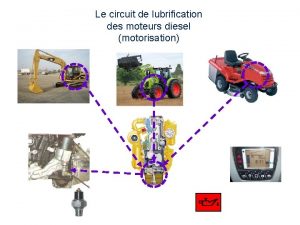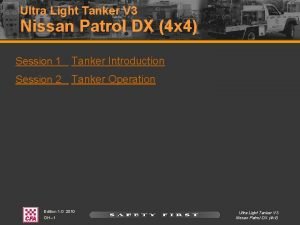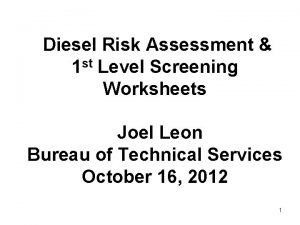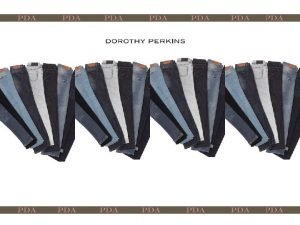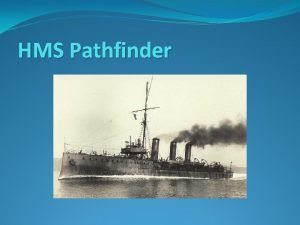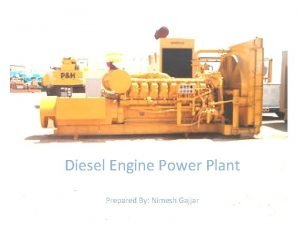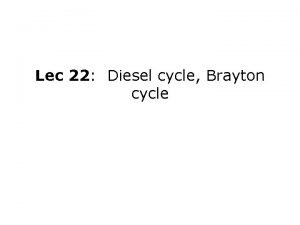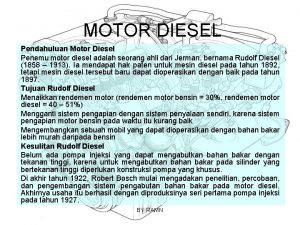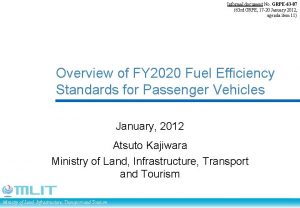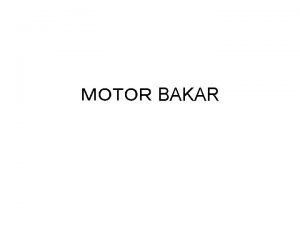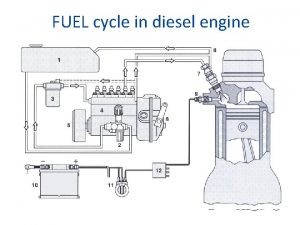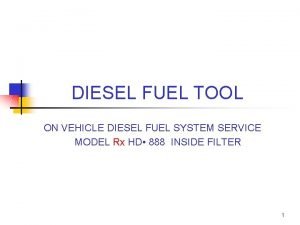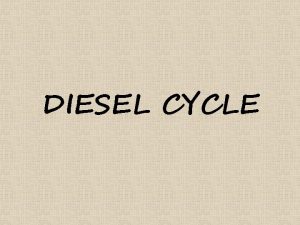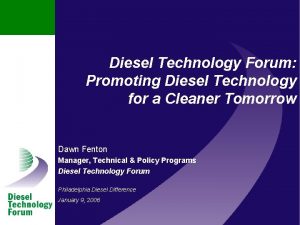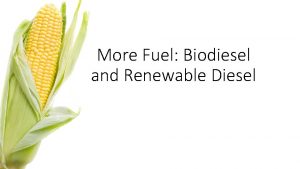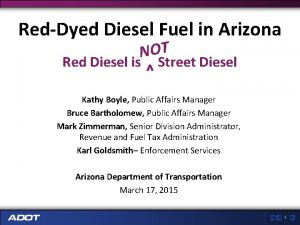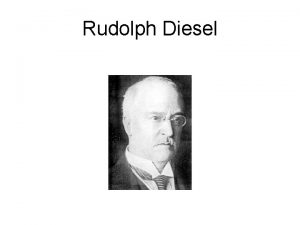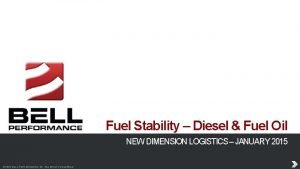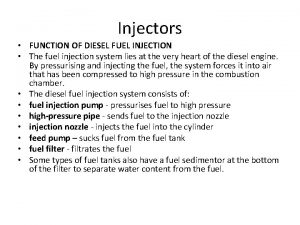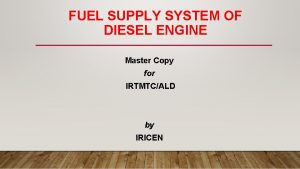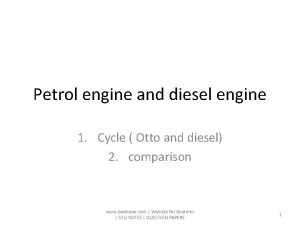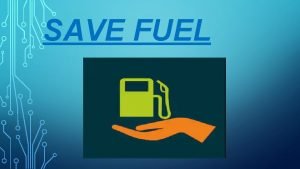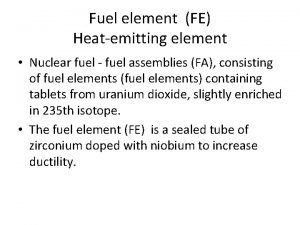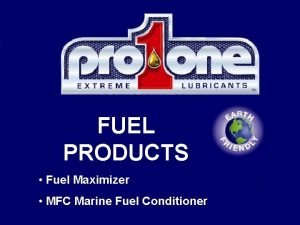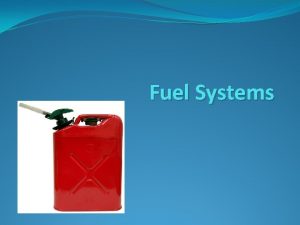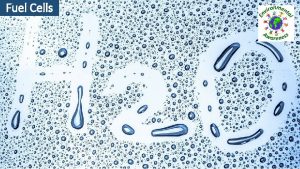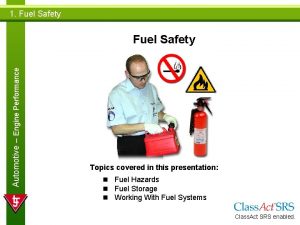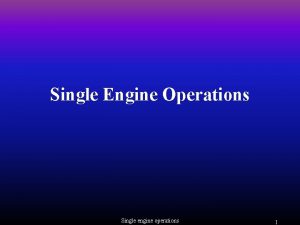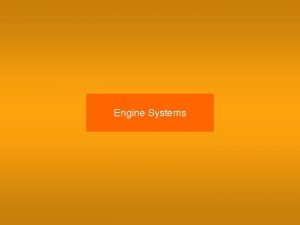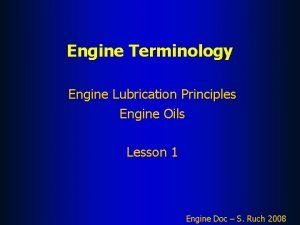Engine Technology Diesel Engine Diesel Fuel Diesel fuel
































- Slides: 32

Engine Technology Diesel Engine Diesel Fuel • Diesel fuel comes from the middle distillate group, which has properties and characteristics different from gasoline • Diesel fuel properties and characteristic 1. Viscosity – measure of a fluid's resistance to flow 2. Wax Appearance Point and Pour Point Temperature 3. Volatility 4. Cetane Number or Rating 5. Diesel Fuel Grades High Pressure Diesel Fuel Injection • All diesel engines use a high pressure fuel injection system that differs from gasoline fuel injection systems

Engine Technology Diesel Engine Combustion Cycle in a diesel engine 1. The delay period – an initial delay as the fuel changes from a liquid state to a vapor or gas state 2. The uncontrolled burning period – the fuel already injected into the chamber

Engine Technology Diesel Engine Combustion Cycle Combustion in a diesel engine 3. The controlled burning period – the injector continues to feed fuel into the combustion chamber 4. The after burning period – all the remaining fuel in chamber continues to bum until it is consumed

Engine Technology Diesel Engine • Combustion of diesel fuel is not identical under all conditions & depends on: 1. 2. 3. 4. 5. 6. Injector timing Length of time (or pulse width) of injection Position of injector nozzle Injection pressure Vaporization of fuel Distribution of fuel in the combustion chamber • four most commonly used fuel injection pumps system 1. Inline fuel injection pumps system - row cam actuated pumping elements, one for each engine cylinder - commonly used in diesel engines for heavy commercial vehicles

Engine Technology Diesel Engine 2. Distributor type injection pump system - Serves several engine cylinders by one or two plungers from which the fuel is directed to each cylinder by a distributor system - This type of pump is used maximum on cars & light commercial vehicles 3. Unit injection system - A combined pump and injection unit. Each unit serves one cylinder. Engine camshaft actuates all these - Unit injection seems to become most widely used system in the future to combat exhaust emissions 4. Common rail of high pressure supply system - Used small accumulation tank called Rail where the pressure of the fuel remains almost constant and always available in order to supply the electronic injectors

Engine Technology Diesel Engine CI Engine Fuel Supply System • main components of the fuel system 1. 2. 3. 4. 5. 6. 7. fuel tank fuel pipes / lines coarse filter fuel feed pump fine filter high pressure pump injector

Engine Technology Diesel Engine Fuel tank • form a sump in the base of the tank in which water if any, accumulates. Fuel line • 2 type of fuel line 1. Low Pressure Line – from tank to high pressure pump through feed pump and filters. Pressure about 28 to 98 k. Pa (4 to 14 psi). 2. High Pressure Line – from the high pressure pump to the injector. Must short, straight, and stiff as practicable to avoid excessive vibration. The pressure over 98100 k. Pa (14228 psi). • pipe materials are 1. Mild steel, which is zinc or tin plated for protection against corrosion 2. Seamless tubes with accurate bore 3. Stainless steel pipes may be the alternative to steel pipes

Engine Technology Diesel Engine Fuel filter • To protect fuel injection system of diesel engine from harmful abrasives, because clearances between injector parts is very closed. • Two type of fuel filter are used: 1. primary (coarse) filter 2. secondary (fine) filter – combination of primary filter and sedimentor • Primary filter protects the feed pump against the harmful abrasives and secondary filter removes the very fine particles that have passed through the primary • Some vehicles are equipped with a water separator in fuel system. A fuel water separator works much like a filter, except that the element is replaced by a baffle

Engine Technology Diesel Engine

Engine Technology Diesel Engine Mechanical feed pump • delivers fuel from tank to injection pump continuously and at reasonable pressure (29 – 98 k. Pa), if not there is a possibility of formation of vapor bubbles and subsequently cavitation. • The result is uncontrolled variations of fuel delivery rate to the cylinders, it causing rough running and possibly mechanical damage to the engine & mechanical damage in the injection pump. • Two type of fuel transfer / feed pump: 1. Diaphragm type fuel transfer pumps – the design and principle operations is similar to the lift pumps used for petrol engines. 2. Plunger type fuel transfer pumps – there two type pumps are available, one single and the other double acting.

Engine Technology Diesel Engine Mechanical feed pump

Engine Technology Diesel Engine Fuel injection pump • functions of the fuel injection pump (FIP) are as follows: 1. Supplies fuel precisely at the right point in the diesel cycle. 2. Meters quantity of fuel delivered per cycle to match the torque speed relationship demanded by the engine. 3. Provides very high pressure energy so that the injector can effectively atomize, mix and evaporate it in the air in the extremely short time interval available in the cycle. 4. Provides rectangular pulse fuel delivery characteristic – having an extremely steep rise and termination of pressure with a flat top in between. 5. Required to be shaped both to meet emissions requirements and to keep noise down to acceptable levels.

Engine Technology Diesel Engine Fuel injection pump • In order for the engine to operate smoothly, the following fuel injection conditions must exist. 1. Pressure must be available at the precise instant of fuel injection into the chamber. 2. Injection rate must be equal for all cylinders so there are equal power pulses from each cylinder. 3. Pressure must shut off at the precise instant to control the total amount of fuel to be injected. • Several different types of pump systems are used 1. inline type fuel injection pump - Contain a transfer pump, governor and injection pump within the distributor pump housing. - Uses an external supply pump to deliver fuel to the transfer pump to fuel pressure and passes the fuel on to the injection pump where it is further pressurized for injection into the cylinders.

Engine Technology Diesel Engine Fuel injection pump • 2. distributor type injection pump - a single unit, made up of a supply pump, governor, and injection pump. - Supply pump draws the fuel from the fuel tank and delivers it to the distributor pump housing. - Injection pump then increases the fuel pressure to the levels needed for the combustion. - Governor controls the speed of the engine • 3. unit injector - fuel injection pump and injector in 1 unit

Engine Technology Diesel Engine Inline Fuel injection pump • Multicylinder inline (element) injection pump has a plunger and barrel assembly for each engine cylinder. • Each element contains a plunger, a barrel, and a delivery valve all placed in a single row in a casing made in three parts. 1. One part is a steel T-shaped body containing the fuel passages and pumping elements. Second is an aluminum alloy cam box and governor housing, which contains the camshaft and bearing, cam followers, control rod, governor assembly, and operating linkage. Delivery valve assembly 2. 3. • • Camshaft creates the plunger movement for each pumping element occurring in the firing order and at the correct point in the engines cycle of operation Governor senses the changes in engine speed and, in conjunction with the accelerator lever position, automatically regulates the amount of fuel to be injected

Engine Technology Diesel Engine

Engine Technology Diesel Engine

Engine Technology Diesel Engine

Engine Technology Diesel Engine • Function of delivery valve is to provide 1. Residual pipeline pressure, so that each successive pumping stroke immediately actuates the injector (about 2945 k. Pa / 427 psi). 2. Rapid fuel cut off, to eliminate injector nozzle dribble 3. Positive continuous air purging or bleeding • During its injection stroke, the pressurized fuel lifts the delivery valve, so that fuel is displaced towards the injector. When the plunger aligns the helical groove and the spill port, the injection stops and delivery valve is then immediately closed by the return spring

Engine Technology Diesel Engine Distributor Fuel injection pump • Two main types of pump in use are 1. Rotary types distributor pump – plungers reciprocate in the head of the distributor rotor while revolving around its axis, similar to the Lucas and Standyne units 2. Axial plunger distributor pumps – pumping plunger is coaxial with the drive shaft and rotating with it, serves also as the distributor, similar to the Bosch VE series • Generally distributor type fuel injection pump lighter, compact and less costly than the inline pump counter parts. Also, their governors and injection advance devices are simpler and smaller. This type of pump usually incorporates a transfer pump used for keeping it full of fuel and also for powering many of the control systems. Consequently, transfer pump delivery pressures of up to 785 k. Pa (114 psi) and above are necessary.

Engine Technology Diesel Engine

Engine Technology Diesel Engine

Engine Technology Diesel Engine Governor • The general functions of a governor are as follows: 1. To supply extra fuel for starting the engine at various temperatures experienced during service. 2. To maintain the idling speed constant at a predetermined rpm regardless of temperature and load. 3. To prevent the engine from over-speeding if the accelerator is depressed suddenly at light load or the load is suddenly reduced. 4. An all speed governor maintains, within preset limits for full and zero loads, a constant speed appropriate to the accelerator pedal angle, regardless of variations in load.

Engine Technology Diesel Engine Governor • Three main types of governor used for inline pumps are: 1. Mechanical (heavy duty engine) - Mounted at the end of injector pump. Contains two weights, rotated by the pump camshaft. When engine stationary position, flyweights are fully retracted, so that the control rod is held in the maximum fuel position required for starting the engine. - Once the engine is started, rotation of the weight causes the centrifugal effect to overcome the spring force and the weights then take the position where the control rod is withdrawn to the idling setting.

Engine Technology Diesel Engine

Engine Technology Diesel Engine Governor 2. Pneumatic (light duty) - Spring loaded diaphragm connected to the control rod, seals a chamber and is connected by a pipe to a venturi control unit in the inlet manifold. A butterfly valve, fitted in the waist of the venturi, is linked directly to the accelerator pedal. - After starting of the engine, operation of the accelerator pedal produces a depression in the venturi and diaphragm chamber so that atmospheric pressure forces the diaphragm and control rod to the idle setting. - A stop screw, acting on the lever and controlling the butterfly valve, limits the maximum speed. 3. Hydraulic - Used with inline pumps where smooth, slow idling speeds are desired. A gear type oil pump is driven from the end of the pump camshaft, and supplies oil through various valves to operate a piston connected to the control rod. High cost of this system limits use.

Engine Technology Diesel Engine

Engine Technology Diesel Engine Injector / Injection Nozzle • The main functions of the injector are: 1. To develop the pressure at which injection begins. 2. To control the rate of injection for achieving the required rate of increase in pressure and a combustion process that is compete without generating harmful emission. 2. To inject the fuel into the combustion chamber in a manner such that all of it atomizes, and mixes with and evaporates into the air as completely and uniformly as possible within the available time. 3. To terminate injection instantaneously at the appropriate time, without any dribble or after injection, leaving the combustion chamber completely sealed off from the fuel system.

Engine Technology Diesel Engine Injector / Injection Nozzle • There are three basic types of nozzle in common use. These include: 1. The pintle type – conical seating face which at its end has a pintle projecting into the hole. Opening pressure normally about 10 to 13 MPa (1450 to 1885 psi). Used for indirect injection engine. 2. The hole type – has one, two or more holes at nozzle tips. Location of holes depand on location of injection nozzle. Opening pressure is higher than pintle type, 15 to 25 MPa (2175 to 3625 psi). Suitable for direct injection engine. 3. Two stage injection (Pintaux) type – this nozzle incorporate provision for cold starting.

Engine Technology Diesel Engine • Valve is lifted from its seat by the steeply rising pressure of fuel between 5 MPa (725 psi) and 28 MPa (4061 psi). Initial lift rate is influenced also by the valve seat angle and width.

Engine Technology Diesel Engine Starting Devices • Since diesel fuel does not vaporize or ignite as readily as gasoline, starting devices are required on diesel engines. These include glow plugs, fuel heaters, and engine block heaters.

Engine Technology Diesel Engine Differences between Diesel Engine and Petrol Engine • The main differences between the gasoline engine and the diesel engine are: S. I Engine C. I Engine Fuel consumption 100% 70% Compression ratio 6 - 12 14 - 22 Final compression pressure 11 – 18 bar 30 – 55 bar Final compression temperature 400 - 600º C 700 - 900º C Maximum combustion pressure 40 – 60 bar 65 – 95 bar Ex. Temperature at full load 700– 1000 C 500 – 600 C High = 3% Low = 0. 5% Torque at low speed Low High Nox + carbon particles Low High+carbon CO
 Diesel engine fuel system diagram
Diesel engine fuel system diagram Sunoco diesel fuel quality
Sunoco diesel fuel quality Disadvantages of diesel engine
Disadvantages of diesel engine Starting air system
Starting air system Diesel engine power plant working animation
Diesel engine power plant working animation Efi diesel engine
Efi diesel engine Fuel injection system in petrol engine
Fuel injection system in petrol engine Gas turbine fuel system
Gas turbine fuel system External vs internal combustion engine
External vs internal combustion engine Slatten racing engines
Slatten racing engines Diesel körfolyamat
Diesel körfolyamat Circuit basse pression moteur diesel
Circuit basse pression moteur diesel Use a catalyst seed wow
Use a catalyst seed wow Ciclo diesel 4 tempos
Ciclo diesel 4 tempos Rnw diesel
Rnw diesel Evolucion objetos tecnologicos
Evolucion objetos tecnologicos Diesel vs hybrid
Diesel vs hybrid Distinguish between octane number and cetane number
Distinguish between octane number and cetane number Diesel fired steam boiler
Diesel fired steam boiler Vin diesel movies
Vin diesel movies Powerpoint motore a scoppio
Powerpoint motore a scoppio Ciclul otto
Ciclul otto Schéma circuit de lubrification moteur
Schéma circuit de lubrification moteur Light tanker for supplying water or fuel
Light tanker for supplying water or fuel Diesel risk assessment
Diesel risk assessment Dorothy perkins stockists
Dorothy perkins stockists Jane maddock diesel
Jane maddock diesel Lubrication system in diesel power plant
Lubrication system in diesel power plant Diesel lec
Diesel lec Carnot körfolyamat
Carnot körfolyamat Penemu pompa injeksi pada motor diesel adalah …
Penemu pompa injeksi pada motor diesel adalah … Diesel history
Diesel history Perbandingan antara daya efektif dengan daya indikator
Perbandingan antara daya efektif dengan daya indikator
